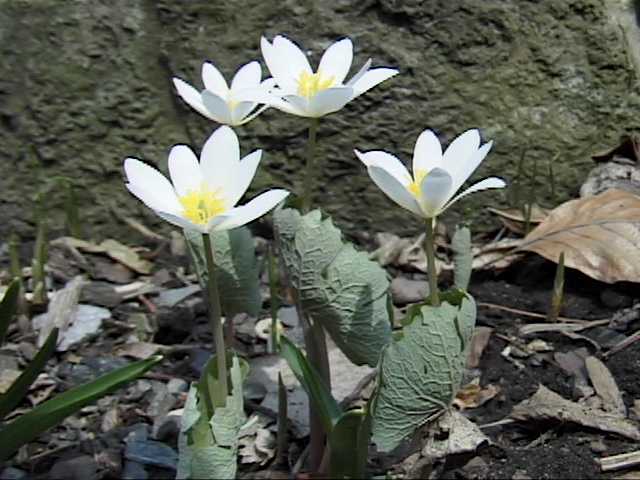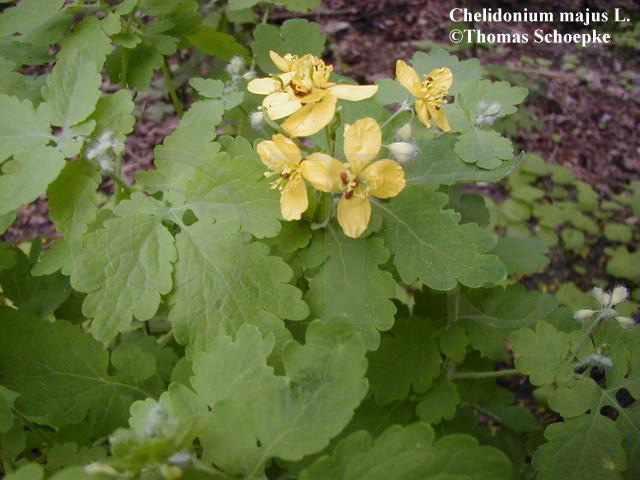The Poppy Family
 |
 |
| Papaver rhoeas |
Bloodroot Sanguinaria canadensis |
The Papaveraceae are found primarily in north temperate to subtropical regions. Few can be found in southern montane
Africa and eastern Australia. The most diversity is found in western North America and temperate Eurasia. There are
42 genera and 660 species. The common genera found in the US and Canada are Aregmone, Papaver, Eschscholzia and
Corydalis. The plants are mostly annual or perennial herbs but can be vines, shrubs or tress.
Click here for a distribution map of the Papaveraceae in the U.S.A.
Vegetative Characters | Reproductive Characters |
Diagnostic Characters | Economic Importance/Fun Facts
| Evolutionary Adaptations and Relationships | Glossary of Terms |
References and Links | Pictures
- usually annual or perennial herbs
- acrid sap that can be watery or colored
- leaves simple to compound, typically lobed
- leaves are usually alternate in a basal rosette,
can be cauline and exstipulate
- have lacticifers, elongate sacs or secretory cells
Back to top
- inflorescence variable
- flowers can be actinomorphic or zygomorphic
- flowers perfect and hypogenous
- 2-3 distinct large sepals that enclose the bud and fall
off when flower opens, or
small and bract-like
- calyx caducous and imbricate
- corolla usually 4-6 petals
- petals variable
- 6 diadelphous or many whorled stamen
- winged filaments, other characteristics variable
- 1 pistil
- compound ovary with 1 locule
- parietal placentation
- fruits are variously dehiscent capsules with arillate seeds
Back to top
- usually simple, lobed alternate leaves
- 2-3 sepals
- usually lack stipules
- 4-6 variable petals
- fruit is a capsule
- lactifers
- white, cream, yellow, red sap
Back to top
- drugs from alkaloids in sap and unripe capsules of Papaver somniferum
(opium poppy-opium, morphine, heroin, codeine
- drugs from rhizomes of Sanguinaria canadensis blood root
- seeds and oil of Papever somniferum are edible
- ornamentals
Back to top
- monophyly supported by morphology and nucleotide date
- 2 hypothesists on the phylogenetic relationships in the family
- 1. basal members are in subfamily Platystemonoideae based on morphological
characters
- 2. Pteridophyllum is sister to all other genera based on morphological
and nucleotide sequences
- Lactifers of Papaveraceae and secretory cells of Fumarioideae
are homologous structures
Back to top
- diadelphous- stamens in two bundles
- exstipulate- no stipules
- caducous- falling of early
- imbricate- overlapping
- arillate- having an aril
- aril-apendage on outside of the seed
- lactifers- where the sap is produced
Back to top
- Judd et al., 1999. Plant Systematics: a phylogenetic approach. Sinauer Associates, Inc. Sunderland, MA U.S.A.
- Walters, D.R. and D.J. Keil, 1996. Vasccular Plant Taxonomy, Fourth Edition. Kendall/Hunt Publishing Co. Dubuque, IA 52002
- Zomlefer, Wendy B., 1994. Guide to Flowering Plant Families. The University of North Carolina Press Chapel Hill, NC USA.
- Little, John R. and C. Eugene Jones, 1980. A Dictionary of Botany. Van Nostrand Reinhold Company, New York, NY U.S.A.
- http://www.doh.dot.state.nc.us/operations/dp_chief_eng/roadside/wildflowerbook/images/page26b.jpg
- http://www.peppermintcottage.com/images/Bloodroot.JPG
- http://www.botany.hawaii.edu/faculty/carr/images/den_rig.jpg
- http://www.gnosticgarden.com/images/poppy.jpg
- http://www.rangenet.org/directory/christiec/plants/papaveraceae/ARCA4.jpg
- http://www.chiaz.com/provings/Argemone/images/argemone1.jpg
- http://www.sciencebuff.org/BOTANYCATALOGUE/dicecana.jpg
- http://www.pharmakobotanik.de/systematik/7_bilder/c920/C92-0118.jpg
Back to top
 |
 |
| Tree PoppyDendromecon rigida |
Capsular fruit Papaver somniferum |
 |
 |
| Arctomecon californica |
Argemone pleicantha |
 |
 |
| Dicentra canadensis |
Dutchman's breeches
Dicentra cucullaria |
 |
 |
| Corydalis incisa |
Chelidonium majus |

Back to top
For questions or feedback, contact:
Catharine Calandra











